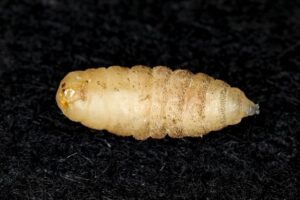Ladybugs are beloved garden insects, but are they as harmless as they look? In this article, we’ll take a closer look at two uncommon species of ladybugs, the black and white ladybugs.
The good news is black and white ladybugs are not toxic to humans. The bad news is they can harm animals if they eat them. Even though they don’t carry human-transmittable diseases, it doesn’t mean they won’t cause negative effects on some people, especially those who are allergic to them.
Read on to learn more about these backyard insects, such as possible treatments and tips on preventing the entry of black and white ladybugs into the house.
Interesting Facts About Black Ladybugs

Do Black Ladybugs Exist?
Yes, black ladybugs exist! They’re called the Twice-Stabbed Lady Beetle (Chilocorus stigma). They’re often mistaken for Kuwana’s Lady Beetle (Chilocorus kuwanae), a small black lady beetle native to Europe, Northern Asia (except China), and Southern Asia.
Where Are Black Ladybugs Mostly Located?
Black ladybugs live in most parts of Canada, the United States (excluding the Sierra Nevada), and North America (excluding the west coast). Species from the Chilocorus family often thrive in different parts of trees, such as their leaves and roots.
In Michigan, you’ll usually find this ladybug species in plantations for Christmas trees and forests where there’s an infestation of scale insects (small insects with a protective shield-like scale).
Appearance
You can identify black ladybugs by the similar-looking red spot on each of their outer protective shell (elytra). Meanwhile, the following ladybug’s parts are entirely black:
- Elytra (except for the twin red spots),
- Head, and
- Pronotum (area above the elytra directly behind the head).
Did you know that your fingernails and the elytra of ladybugs are made of the same material? Now, you know.
Size
They’re small (3 to 5 millimeters in length) and very round. If you flip them over, you’ll notice an orange-red color on their abdominal segments, just below the legs.
Behavior
Black ladybugs are active in different months. In Vermont, they’re usually active from March to November. In New York, it would be the months of April to May. Adult black ladybugs seem to be plentiful from late June to early August.
Food
These ladybugs are beneficial. Therefore, you don’t want to kill them, especially if you have a garden to maintain. They have strong mouth parts that enable them to hunt and chew through the protective covering of plant-harming insects. They usually prey on sap-sucking aphids or those tiny lime green bugs.
Ladybugs can eat at least 50 aphids daily, or as many as 5,000 aphids over their lifetime.
Susceptible to Broad-spectrum Insecticides
Similar to other insects, this ladybug species is susceptible to broad-spectrum insecticides. A broad-spectrum insecticide can kill a wide variety of groups or species of harmful organisms. So, experts often recommend using less toxic alternatives, such as horticultural oils.
What Are the Tiny Black Bugs in the Bathroom?
What You Need to Know About White Ladybugs
White ladybugs could refer to three species of white ladybugs in the Coccinellid (lady beetles) family:
- Fifteen-spotted Lady Beetle
- Ashy Gray Lady Beetle
- Twenty-Spotted Lady Beetle
Let’s get to know them better:
1. Fifteen-Spotted Lady Beetle
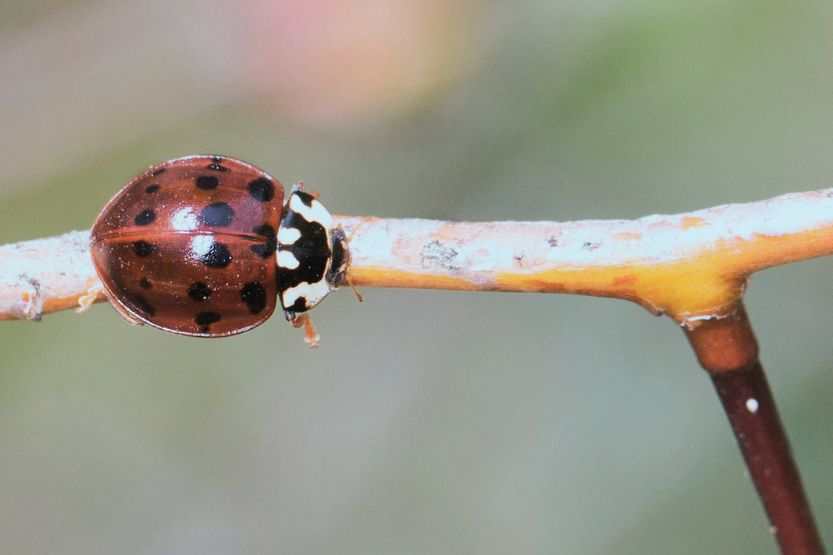
Location
In the entomology world, the Fifteen-Spotted Lady Beetle is known by its scientific name Anatis labiculata. You’ll find this species mostly east of the Atlantic Ocean, Northern Manitoba, South Texas, West Colorado, and South America.
Size
The Fifteen-Spotted Lady Beetle is longer than a black ladybug by 4.2 to 4.5 millimeters. And unlike a black ladybug, it’s a little more oval.
Appearance
The color of its shell (elytra) that’s covering its wings is ashy-gray in color. As it ages, the color becomes darker—from ashy-gray to orange to black or deep purple.
It has a distinct M-shaped spot in the center and an inverted small V-shaped spot on the white margin of the covering over its head. Overall, it has 15 black spots.
2. Ashy Gray Lady Beetle
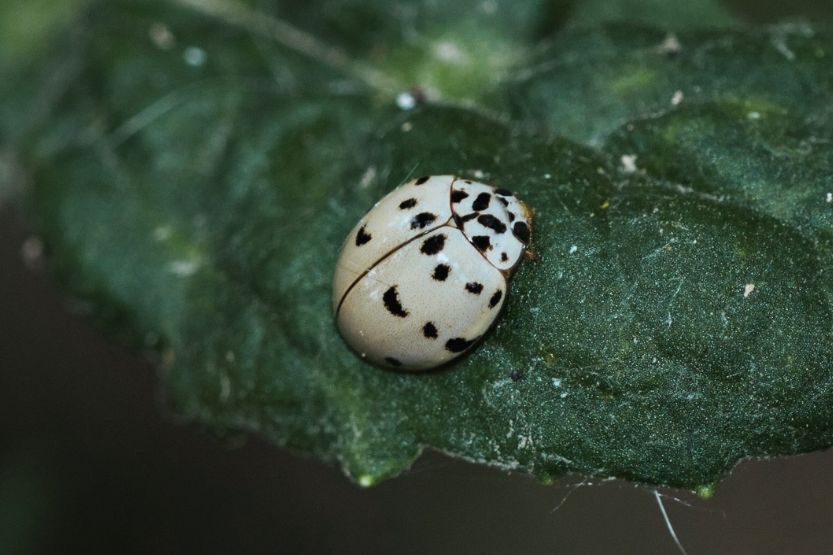
Lifespan
An adult Ashy Gray Lady Beetle (Olla v-nigrum) can live up to two years.
Location
It’s usually harmless—if you leave it alone—and lives mostly in Central America, North America, and Oceania (consists of 14 countries, like Australia).
Since it spends the winter in buildings, it’s not uncommon for it to encounter humans.
Appearance
As its name suggests, the Ashy Gray Lady Beetle has a gray or white shell (elytra) covered with 2 to 15 black blotches. Its head and pronotum also have black blotches.
3. Twenty-Spotted Lady Beetle
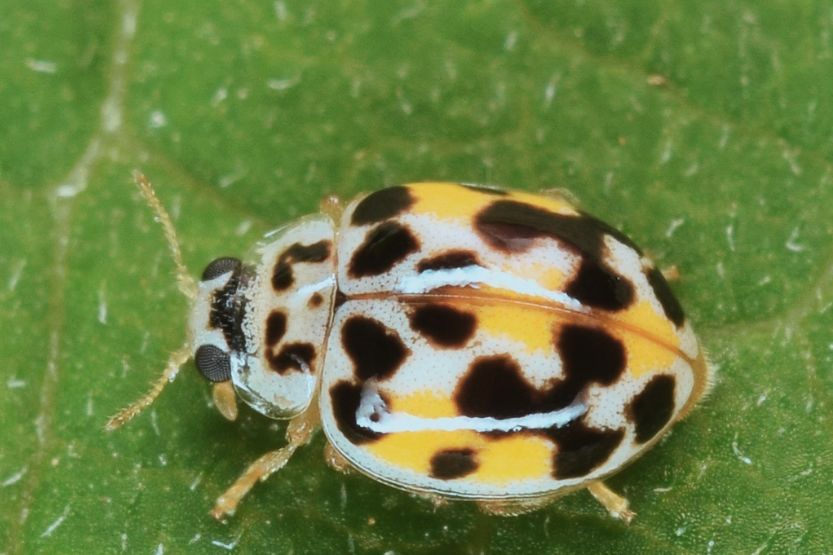
Size
Compared to the other two, the Twenty-Spotted Lady Beetle (Psyllobora vigintimaculata) is quite rare and smaller (measures 2 to 3 millimeters).
Location
It’s native to North America but also lives in Alaska, Labrador (the easternmost part of Canada), and Mexico.
Appearance
The base color of the Twenty-Spotted Lady Beetle’s elytron is usually pale (ranging from white to light tan). There are four dark mottled spots on its pronotum and nine mottled spots on its elytron.
Feeds on Fungus
The Twenty-Spotted Lady Beetle isn’t a carnivore. It has rake-like small teeth that allow it to gather and feed on fungus, like the powdery mildew on leaf surfaces.
What Are the Tiny White Bugs in the Kitchen and How to Get Rid of Them?
Are Black and White Ladybugs Poisonous?
Do Not Pass on Disease-causing Bacteria or Viruses
“Are black and white ladybugs poisonous to people?” Fortunately, the answer is no. They don’t extract blood or pass on disease-causing bacteria or viruses.
Black and White Ladybugs Can Bite Humans
While black and white ladybugs can bite humans, it rarely happens. The Asian lady beetles (Harmonia axyridis) are more aggressive in biting humans. These bites usually occur when there’s a short supply of liquid nourishment.
However, if you have allergies or a family history of allergies, you might develop an allergic reaction if a ladybug bites you. In addition, ladybugs’ excrement can make your allergy worse.
Severe Allergic Reaction Due to the Bacteria or Virus Carrier Ladybug
Also, there have been instances wherein a ladybug carries bacteria, parasites, or viruses in its saliva. This could lead to a severe allergic reaction, just like in the case of professional bodybuilder Reza Remand.
In November 2016, he noticed that the roof of his car was covered with ladybugs. He didn’t mind them and even let them walk over his hand.
Soon after, he felt a sharp pain that started on the left side of his neck and quickly spread to his left foot. By the next day, his foot had swollen and turned black.
He was rushed to the hospital. His doctor discovered that he had developed a life-threatening body response to an infection called sepsis, caused by a fungal infection passed on to him through the ladybug’s saliva.
Note: The ladybug species that bit Reza wasn’t a black or white ladybug. Their aggressive family member was the culprit—the Asian lady beetle. You can read the full story on The Guardian website
50% of People Claimed They’re Allergic to Ladybugs
According to an anonymous survey by Dr. Kusum Sharma and her colleagues, as many as 50% of people in certain places claimed they’re allergic to ladybugs.
The researchers presented this preliminary study on ladybugs—to be more precise, the multi-colored Asian lady beetle (Harmonia axyridis) species—at the American Academy of Allergy, Asthma, and Immunology meeting.
What Makes Some People Allergic to the Ladybug’s Bite?
Unlike humans, ladybugs have an open circulatory system. This means that their blood, a dark fluid called hemolymph, isn’t confined within blood vessels. It flows freely throughout the cavities of their body.
They release hemolymph as a physical deterrent to predators whenever they feel threatened or are attacked. This ladybug equivalent of human blood doesn’t smell or taste good.
It contains high concentrations of proteins, which can trigger an allergic reaction in some people. Researchers also found that the same proteins are present in croton bugs, also known as German cockroaches.
Allergy Symptoms
According to the research of Dr. David W. Goetz, an allergy specialist, anyone can become allergic to hemolymph, regardless of age. If you’re allergic to ladybugs, you might experience the following symptoms:
- Cough
- Itchy eyes
- Mouth numbness
- Rash
- Runny nose
- Shortness of breath
- Sneezing
Again, are white and black ladybugs poisonous? Black and white ladybugs are not poisonous to humans but can be dangerous to pets. These ladybugs do not carry diseases, but they can be quite harmful to people with a history of allergies.
Are Black and White Ladybugs Poisonous to Pets?

Ladybugs are only bad for your pets, like cats and dogs, if they eat them. And they have to eat lots of them to experience any serious negative effects. Since ladybugs taste bad, they’ll likely spit them out and never eat one again.
Is There Any Chance Ladybugs Can Kill Your Pets?
It’s improbable they can be deadly when ingested, but it doesn’t mean you should be lax.
Most Toxic Ladybugs
According to a 2015 article published in the online peer-reviewed journal Scientific Reports, these are the most toxic ladybug species, with the orange ladybug as the most dangerous and the larch ladybug as the least toxic:
- Orange ladybugs (members of the Asian Lady Beetle family)
- Two-spotted Ladybugs (usually have red elytra with two black spots)
- Pine Ladybird (Exochomus quadripustulatus)
- Fourteen-spotted Lady Beetle (yellow elytra, each with seven black spots)
- Larch ladybugs (usually light brown)
Case of a Dog with 30-40 Asian Beetles on Its Mouth’s Roof
The New York Daily News reported in 2016 about a Kansas dog named Bailey, who its owner brought to the Hoisington Veterinary Hospital. The owner was concerned because Bailey had stopped eating, and foam started to form in his mouth. The canine was also a little lethargic.
What did the veterinarian discover? When he opened the canine’s mouth, he found 30 to 40 Asian beetles latching on the roof of its mouth.
But why do ladybugs live inside an animal’s mouth?
Ladybugs thrive best in humid conditions. That’s why when the outdoor temperature drops and humidity becomes low; they’ll more likely move to a warmer environment, like your pet’s mouth.
Can Ladybugs Infest a Dog’s Mouth?
Luckily, a ladybug infestation inside a dog’s mouth is uncommon. If it does happen, you need to address the issue fast. The longer these bugs stay in your pet’s mouth, the more painful sores they’ll cause.
What to Do If You Find Ladybugs in Your Dog’s Mouth
- Carefully remove each ladybug using tweezers.
- If they burrow into your pet’s mouth, you need to bring your pet to a veterinarian. The veterinarian will usually administer a sedative, so they can safely remove the pests with tweezers. Your pet might also need antibiotics to treat the remaining injuries.
- Let your pet drink plenty of water to prevent ladybugs from sticking to its mouth.
- Regularly check your pet’s mouth for ladybugs and other insects.
- Seal cracks in your home to prevent ladybugs and beetles from slipping inside.
Ladybugs Secrete Hemolymph as a Defense Mechanism
As I mentioned earlier, ladybugs secrete hemolymph as a defense mechanism. Hemolymph contains microsporidia, fungi-related intracellular parasites.
Ladybugs have learned to deal with these parasites, so they use them instead to cause chemical burns to any creature that comes in contact with their “blood.”
Often, if the injury is mild, you don’t need to do anything because it will heal independently. However, there’s a possibility that your pet could get an infection from the painful ulcers and cuts, which could result from chewing the tough outer shell of ladybugs.
The infection might require treatment by a veterinarian.
Symptoms of Ladybug Toxicity in Dogs
- Behavioral changes
- Cuts (caused by the sharp pieces that broke off from the ladybugs’ hard shell)
- Difficulty in defecating (due to their digestive organs’ inability to chew the hard shells)
- Excessive salivation
- Excessive sleepiness
- Ulcers
- Vomiting
Symptoms of Ladybug Toxicity in Cats
- Abdominal pain
- Bloody stools
- Loose bowel movement
- Nausea
- Ulcers
- Vomiting
Signs and Symptoms After Ingesting Insecticide-contaminated Ladybugs (Cats)
Your cat or dog may display additional symptoms if it consumes ladybugs contaminated with insecticides. Cats might display the following signs and symptoms:
- Difficulty breathing
- Dilated pupils
- Excessive sleepiness
- Too much drooling
- Head tilt
- Muscle twitches
- Poor appetite
- Runny eyes
- Seizures
- Tremors
- Unsteadiness
- Vomiting everything
Signs and Symptoms After Ingesting Insecticide-contaminated Ladybugs (Dogs)
Dogs might display the following signs and symptoms after ingesting insecticide-contaminated ladybugs:
- Anorexia
- Depression
- Excessive salivation
- Fever
- Loose bowel movement
- Seizure attacks
- Tremors
- Vomiting
What Are the First Aid Steps to Treat a Ladybug Bite?
1. Call 911 or the Local Medical Emergency Number for Serious Allergic Reaction
Call 911 or your local medical emergency number if you develop a serious allergic reaction to these insects. Some possible signs and symptoms of a serious allergic reaction to a black or white ladybug bite include:
- Difficulty breathing
- Feeling dizzy or fainting
- Hives
- Loose bowel movement
- Nausea or vomiting
- Severe swelling of any area of your body or face, such as your eyelids and lips
- Weak and rapid pulse
2. Wash the Affected Area with Soap and Lukewarm or Hot Water
Gently wash the affected area with mild soap and water to remove contaminants. Use lukewarm, not hot, water to relieve skin itchiness and irritation.
3. Place a Cold Compress to Ease Swelling
Place something cold on the affected area for 10 to 20 minutes to ease pain and swelling. You could use ice cubes or a cloth dipped in cool water and then place it inside a sealable plastic bag. A bag of frozen vegetables would also work.
4. Apply Over-the-counter Topical Medications
If the bitten area is persistently itchy, you can apply over-the-counter topical medications for itching, redness, and swelling (e.g., calamine lotion and 0.5% or 1% hydrocortisone cream). Make sure to follow the instructions on the label.
5. Apply a Baking Soda Paste to Relieve Itching and Redness
Baking soda could also help relieve itching and redness caused by an insect bite. It’s easy to make a baking soda paste: Combine a tablespoon of baking soda with three parts of water. Mix until you make a paste. Apply enough baking soda paste to the affected area and wash it after 10 minutes.
6. Take Over-the-counter Antihistamines
If topical treatments aren’t enough, you could take over-the-counter anti-itch medications (antihistamines). Your options include the following:
- Cetirizine,
- Desloratadine,
- Fexofenadine,
- Levocetirizine, and
- Loratadine.
Again, always follow the recommended dosage and frequency to avoid adverse effects.
7. Take Over-the-counter Pain Medications
If the pain is unbearable for you, take over-the-counter pain medications (e.g., acetaminophen and ibuprofen). Always follow the recommended dosage and frequency. If you have a known sensitivity to these medications or have severe liver problems, consult your doctor first.
How to Get Rid of Black and White Ladybugs in Your House

Black and white ladybugs in the yard sometimes migrate indoors during the fall to look for a warm place to hibernate. This could create problems for people, especially those with known insect allergies.
Here are a few things you can do to get rid of ladybugs in your house:
Fill Your Home with Scents That Ladybugs Hate
Examples include bay leaves, camphor, chrysanthemums (mums), citronella, citrus, lavender, and peppermint.
Regularly Sweep and Vacuum Your Home
Regularly sweep and vacuum your home, especially the corners of doors and windows, attics, and the space inside the wall. After sweeping or vacuuming, wash the area with soapy water to eliminate any scent that could attract ladybugs.
Sprinkle Diatomaceous Earth Around Entry Points
Sprinkle diatomaceous earth around possible entry points and areas in your home where they’re known to hang out. This fossilized algae powder is perfectly safe for your pets.
How Do I Get Rid of Little Black Flying Bugs in My House?
Conclusion: Black and White Ladybug – Facts and Are They Poisonous?
These colorful insects are rarely seen as poisonous or disease-causing insects. For some people, the black and white ladybug meaning is good luck. For farmers and gardeners, they mean fewer pest problems because they help balance out the aphid population.
But this doesn’t mean they won’t cause harmful side effects. If you have known allergies to insect bites, always take the necessary precautions to ensure the safety of yourself and others.
Read next:



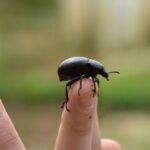
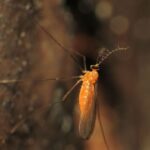
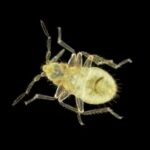
![White Salt-Like Grains in Bed [What Are They?] White Salt-Like Grains in Bed](https://homecarezen.com/wp-content/uploads/2021/12/white-salt-like-grains-in-bed-150x150.jpg)


